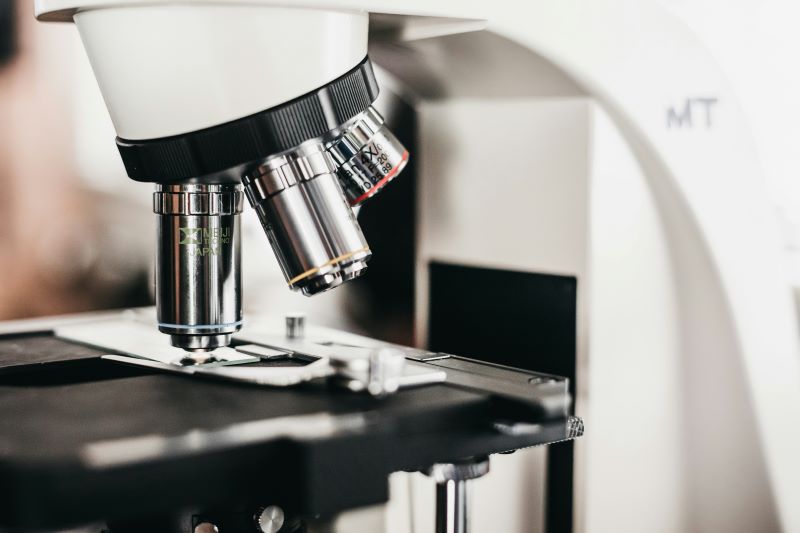| dr Małgorzata Kłoskowicz |
Perovskites are materials that are used in the automotive industry, electronics, photovoltaic panels, and modern scientific research equipment. They are often discussed in the context of the oenergy of the future. The unique properties of oxygen perovskites have been studied for many years by physicists from the University of Silesia. To explain the cause of the observed strong piezoelectric effect, they designed a special attachment for an optical microscope, and their invention has just been patented.
The authors of the patented solution study, among other things, the optical, piezoelectric, dielectric, and thermal properties of crystals and ceramics with a perovskite structure on a daily basis.
‘During our measurements, we observed a gigantic piezoelectric response in one of the PZT crystals. It surprised us. We wondered what could be the source of such anomaly, and how can we verify our hypotheses experimentally’ says Iwona Lazar, PhD, DSc, Associate Professor, co-author of the patent. ‘We suspected that it is related to the dynamics of the crystal’s domain structure in an electric field.
In commercial microscopes, this process can be studied in an electric field perpendicular to the incident light beam using opaque electrodes. However, the problem was that, for the observed phenomenon, an electric field parallel to the light beam had to be used along with light-transmitting electrodes.
We started thinking about how to place electrodes made of transparent material on our crystals so they would function over a wide range of temperatures. The solution was the attachment we designed for the measurement system’ says Prof. Iwona Lazar.
The attachment is relatively small and was added to the system allowing the study of birefringence.
‘The device can, of course, also be used in other microscopes. It’s worth adding that not only physicists but also biologists and chemists interested in the properties of various transparent materials in an electric field can use it’ Adds Andrzej Soczyński, MA, MSc.
‘Our system is unique. It was developed over 20 years ago at the University of Oxford in England and measures optical birefringence several orders of magnitude smaller than that found in well-known crystals such as calcite’ explains Prof. Krystian Roleder.

To explain the cause of the observed strong piezoelectric effect, the physicists from the University of Silesia designed a special attachment for an optical microscope, and their invention has just been patented | photo: Logan Moreno Gutierrez from Unsplash

Different colors correspond to different directions of the polarisation vector with respect to the horizontal line. It is clearly visible how the action of the electric field affects these directions in the perovskite crystal. It is precisely such a clear change in these directions that leads to the giant piezoelectric effect. On the left: domain structure without the field, on the right: domain structure in the electric field | photo: Krystian Roleder
It should be emphasised that the perovskite structure crystals in question are also unique on a global scale. The physicist points out that they are currently produced in only a few places in the world, including at the Military University of Technology in Warsaw by Andrzej Majchrowski, PhD, with whom researchers from the University of Silesia have been collaborating for many years.
We obtain crystals of very high quality. Thanks to the attachment, we were able to observe changes in the domain population in the electric field. The experiment confirmed that the giant piezoelectric effect, mentioned at the beginning by Prof. Iwona Lazar, is due to the change in domain population and the easy change in the direction of the polarisation vector under the influence of even a weak electric field (compared to, for example, the ‘trendy’ relaxors),’ adds the co-author of the invention.
The difference in the value of the piezoelectric coefficient is significant. For quartz, it is 2 pm/V, whereas in the crystals studied by physicists from the University of Silesia, it can reach the level of several tens of thousands. This sensatonal measurement result gives hope for new applications of such materials.
Currently, scientists still have to tackle the problem of stable properties of their materials under changing temperature conditions. The mentioned quartz maintains stable properties over a wide temperature range. Therefore, physicists wish for the studied perovskite structure crystals to have such stability.
The authors of the patented inventions are the scientists from the Faculty of Science and Technology: Iwona Lazar, PhD, DSc, Assoc. Prof., Andrzej Soczyński, MA, MSc, Janusz Koperski, MA, and Prof. Krystian Roleder.
The article ‘From the Unique Property of a Crystal to an Invention’ was published in the May issue of the ‘Gazeta Uniwersytecka UŚ’ (USil Magazine) no 8 (318).





